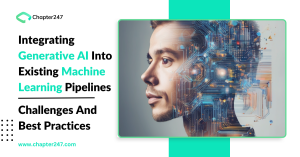The utilization of Artificial Intelligence in business has engendered a host of smart systems that help make optimized business decisions or help offer a personalized user experience to customers. The most popular manifestation of the latter, in recent years, has been the AI-driven Chatbot. A host of business domains, ranging from E-commerce to Hospitality Management has utilized the power of its human-like responses to bolster conventional customer engagement methods, and boost business growth.
Though simplified menu-based or keyword-driven Chatbots have been around for quite some time, their performance has been found wanting in terms of speed of responses as well as conversation quality. Akin to the menu-driven telephone response systems of old, they usually require human intervention for any meaningful query-resolution activity. The true impact of AI in the world of Chatbots can be judged from the contextual Chatbots, which attempt to replicate human-like conversations with unerring precision and display a comprehensive understanding of the true context of a conversation. Using a combination of NLP, Machine Learning through customized heuristics and neural networks, and Reinforcement Learning techniques, these systems have managed to replicate a near-human level of interaction.
Thus, we can define an AI Chabot to be an AI-driven software/system that can simulate near-human levels of interaction with actual people through either textual or vocal stimuli. They are alternatively called talk bots or IM bots.
Let us take a closer look into how to make Chatbots using Artificial Intelligence.

1. Know what the user wants
Before any actual interaction takes place between the Chatbot and the user, it is vital to understand what the user wants. Based on the matrix of Response Mechanism – Conversation Capability defined for AI systems, the Chatbot can be made either Rule-based or in the form of an Intelligent Machine.
A Rule-based system operates well within the boundaries of a particular domain and works on a pre-defined set of rules. These rules could either be menu-driven, in the sense that a banking domain Chatbot would first approach a user with a list of items like “How to open a bank account”, “How to withdraw money” etc. These items would be further fleshed out and the conversation would proceed on a predefined set of rules.
An intelligent machine on the other hand generates real-time responses based on knowledge gathered about a particular domain. This would mean that the Chatbot would attempt to answer any question in a particular domain instantaneously without a predefined rule-set to adhere to. This is more difficult to achieve, but offers greater dividends.
2. Optimize the Chatbot to satisfy User Requests
Now that we have defined a way to solicit requirements from the user, it is important to define the way in which the Chatbot would satisfy these requests.
Once the data regarding the customer requirements has been obtained the Chatbot must decide upon the most appropriate method for handling the query. Customized decision-making heuristics coupled with a strong use of Neural Networks can help to identify the best possible response, and to identify a Question Answer Acknowledgement pattern in the conversation.
Reinforcement Learning can help in pattern recognition of similar queries and responses from the Chatbot’s interaction history to provide optimized responses as well.
3. Test the ‘intelligence’ of the Chatbot
Once we have fixed the requirement elicitation mechanism and solution strategy, it is time to decide whether the Chatbot is ‘intelligent’ enough to solve the business problem it was designed to handle.
The way to do this can be enumerated as follows:
- Check if the Chatbot can understand the end-goals of the user base.
- Check whether the system can define end-goal completion for the user based on a conversation.
- Check if the system can create knowledge about conversation context based on user interaction, and train itself to get better with every conversation by learning from its mistakes.
- Check if the programming is comprehensive enough for the chatbot to cover as much ground as possible in a domain
- Program the chatbot for a functionality
Once this checklist has been satisfactorily fulfilled, it is time to prepare the chatbot for real-life scenarios.

1. Streamline the flow of potential conversations
Once we have ascertained that the chatbot can satisfactorily gather data from user interactions and answer them appropriately, it is time to optimize the way in which the chatbot handles these queries.
The key behind a good conversation is not only in the content of the conversation, but also the way in which the conversation is handled. The chatbot should decide the user journey to make the interaction as beneficial for the user as possible in the minimum time.
Also read about The Benefits of Chatbot in Business Solutions.
2. Plan for future challenges
The Domain-Response matrix divides chatbots into four categories:
- The Rule-based Chatbot, which operates in a domain and replies through a fixed set of responses.
- The Specialist Chatbot, which generates real-time responses in a fixed domain.
- The generalist chatbot, which generates real-time responses for the open domain of knowledge.
- Chatbots which can answer questions in the open domain using a set of rules are considered impossible to practically build as it is considered impossible to codify the entire body of human knowledge for a chatbot.
Though, these chatbots may seem different at the start, they suffer from some common pitfalls which must be taken into consideration before deploying a chatbot in the market.
3. Context Integration
The true context of a conversation is determined not only through the text, but also by analyzing user behavior and background. The same word may be differently interpreted in different geo-political regions and the chatbot with AI must be observed for refining behavior as per the use case.
4. Coherent Responses
Though a response may be correct, it is important that it viewed as coherent by the user. Often the chatbot may provide essential information in an ungrammatical manner, thereby reducing its usefulness.
5. Performance Assessment
With advancing technology, the performance benchmark of the chatbot must be assessed continuously and it must be tuned to perform above and beyond existing SOTA standards to keep it functionally viable for some time in the future.
6. Read Intention Training
Chatbots must be monitored to ensure that they understand not only the user’s problem but also the intended goal of the conversation to deliver optimal results.
Let us build you a Chatbot
Chapter247 Infotech has established itself as a leading name in the world of customized AI powered chatbot development for businesses ranging from the education domain to healthcare. Our staff of engineers and business specialists work out of offices in both India and the US and have delivered more than 800 projects over the last 6 years.
Contact us for the AI powered Chatbot your business deserves.








